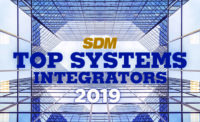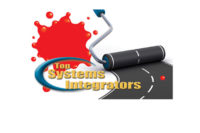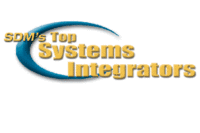
The market for integrated security systems that encompass multiple “subsystems” such as video surveillance, access control, fire and intrusion alarm is rich with opportunities, systems integrators claim inSDM’s third article in a series on the state of the security market. Yet, while both revenue and profits climbed in 2006 and integrators foresee them mounting again this year, they also relate that a factor hindering greater growth is labor — both a general deficiency of available skilled business people, as well as the costs to train and maintain their staffs.
“We feel the state of the market is very good to excellent, and the potential for sales is very good, also,” says Marty Guay, chief operating officer of Securitas Security Systems USA Inc., Norcross, Ga.
Securitas’ entrance into the systems integration business began with its purchase of Pinkerton’s Systems Integration in 1999. Securitas, an international company, has 50 locations and 650 employees in the United States.
Guay believes his organization’s limitation is finding people to “take on the challenge. “It’s not the market. The market is very opportunity-rich. It’s finding the people — either managers or salespeople — who can help the customer. There are more needs than there are people to serve them,” he relates.
By “serve” Guay means “uderstanding the customer, their vertical market, their industry market, their compliance issues, their regulations, and then designing solutions to mitigate the risk that they have.”
It’s more than just new salespeople Guay wants Securitas to have. “It’s really finding business people.
“If we believe that integrated systems are here and have value, then you need to have chefs in the kitchen who know how to create recipes, because every recipe is unique when you are creating integrated systems,” Guay believes. “If we were selling a one-dimensional product that wasn’t integrated, we wouldn’t need creative people in front of the customer.”
INTEGRATORS GAUGE THEIR PERFORMANCE
“Excellent” is how Simpson Security Systems Inc., Alexandria, La., rated the state of the market, also. A strategy that works for Simpson Security is a diverse client base, explains Keith B. Simpson, president and CEO. “It helps fuel the capital for the larger projects.”Simpson defines his firm as a large systems integrator, but not at the exclusion of a middle-market clientele, such as churches, small convention centers, hotels, hospitals and healthcare facilities. The call for security in many of these verticals is for integration of the burglar and fire alarm systems, with a little bit of access control and cameras, he says.
Simpson Security has done systems integration for 15 years, and it counts $375,000 annually from recurring revenue — a business model more precisely typified by alarm companies. Approximately 40 percent of total $7 million in revenue stems from integrated security systems, up from 34 percent in the prior 12-month period.
“I’m seeing a lot more integrated systems. Usually you have six or seven stand-alone systems under one spec; now I’m seeing those six or seven systems under one system spec,” Simpson observes.
Describing the market for integrated security systems as “very good,” Sonitrol of Sacramento, Roseville, Calif., asserts that its growth is consistent. “We currently are selling more projects in the $50,000 to $100,000 range due to the flow of DHS funds funneled through local agencies,” says Jeff Davies, vice president and general manager. “In addition we are seeing that technology is also driving growth — more affordable and higher quality CCTV and access technologies.”
Compared with 12 months ago, the number of integrated security system projects is up 20 percent, and the revenue from those projects is up 12 percent, Davies reports.
“We had a phenomenal year,” exclaims Alan Kruglak, president of Genesis Security Systems LLC, Potomac, Md.
Part of the business model at Genesis Security is to pick good win-win clients, Kruglak says. “We want good positive relationships. Because we deal in a non-bid market, it takes time to develop those relationships. We grew 40 percent two years in a row. I don’t see it happening that way [again this year], because we’re not going after that low-margin bid market.”
Genesis Security, which finished 2006 with $14 million in revenue with a 25 percent operating profit, is just four years old, but was founded by management that had previously owned a systems integration business.
Guay at Securitas believes that industry growth is 6 to 8 percent a year, and that Securitas is outpacing the industry at 8 to 10 percent. From a period 24 months ago, to the same period 12 months ago, Securitas’ U.S. revenue increased approximately 20 percent, he says.

PROFIT PICTURE
But the factors that influence sales are not the same as those that influence profit, the integrators say.For example, Guay says two main things help drive profit, which he admits is improving at Securitas — efficiency and specialization.
“Becoming more efficient because we have more experience is an obvious output of having people do better at what they’re doing,” he says.
The specialization factor involves building the business around vertical markets. “It compresses the sales cycle; it compresses the solution design cycle; it compresses the deployment cycle; the service cycle. It compresses everything, because we’re doing more with the same kinds of people so we have a better understanding,” Guay relates.
These groups at Securitas include banking, retail, healthcare, and national accounts. Petrochemical will be starting soon.
“We are not creating a fancy selling group — it’s an organization within an organization with designers, salespeople, installers,” Guay says.
“Most people try to do a vertical market sales strategy. We have a vertical market customer strategy so the customer in the vertical market is the strategy. The solution we design for them is the strategy. Most people try to fit the customer into their organization. We’re trying to build the strategy around the customer.”
Systems integrator Matrix Security Group Inc., Wilmington, Del., experienced improved profitability in 2006 and expects 2007 to improve yet again.
“Combining disparate information into one single site that the customer can readily access is what integration is about,” states Philip Gardner, managing director.
ARK Systems Inc., Columbia, Md., which has been in the systems integration industry for 34 years, has projected sales for integrated systems to increase by more than 20 percent in 2007, and for the firm to continually improve profit margins acknowledges Mark Bennett, president, who believes the state of the market is “excellent.”
“The greatest effect on our success has been the ability to utilize our existing data networking experience and staff, and life-safety system experience and staff as a single team. Not more than five or six years ago these were completely different departments under one roof. Today ARK exists as a true systems integrator, with the ability to integrate all low-voltage building systems.”
But for some businesses, maintenance of staff contributed to a decline in profits.
Sonitrol of Sacramento explains more fully that their profit decline last year in integrated systems was primarily due to more competition in the CCTV market and introducing more competitive pricing. Other factors were increased technical salaries, training in new technologies and margin erosion in CCTV, Davies admits, adding that profits are expected to rebound this year.
Even though Hurricane Katrina hit the United States in August 2005, its effect is still being felt by many Southern businesses.
“I don’t know if all integrators were affected by the hurricanes, but they definitely affected not only our company but the projects we worked on,” Simpson says. “[New Orleans] hired 3,000 to 5,000 contactors; a majority came from the South. The jobs we were working on were affected,” Simpson relates. For example, on many of Simpson Security’s projects an electrical contractor ran all of the raceways, but since the electrician was short of labor, it caused those projects to proceed slower than expected. “In short I had two projects — one went six months over and one went eight months over — so all that overhead and expense for [the additional] months that we were there.”
Fuel increases also had a negative impact on profits at Simpson Security, because they mandated not only an increase in materials, but also higher costs for operating vehicles and bigger expenses for out-of-state projects, Simpson tells.
Profit margins in 2007 will be more manageable, he believes, because the loss of labor has peaked and fuel costs can be factored in in advance.
Something that helps Genesis Security stabilize its profits are service contracts, Kruglak says.
“Our profit levels were great in 2005 and great in 2006, and they are going to be the same this year as well,” he explains. Genesis is building its recurring revenue base through service contract revenue, and some monitoring. About 90 percent of the firm’s customers have a service contract.
WHAT’S INFLUENCING SALES?
Sonitrol of Sacramento notes four main factors driving sales for the California-based company. The first is commercial building activity.“Our region is enjoying a significant building boom,” Davies says of the Sacramento area.
The other reasons are industry- and company-specific: Aging systems are requiring upgrades which leads to more integration projects; and there is more demand for IP-based video and access control, he notes.
ARK Systems anticipates a high level of sales this year and next, as the government sector ramps up its spending, relates ARK Systems’ Bennett.
“Businesses, state, local and federal governments have been continuously developing budgets; these efforts have been tasked to engineering firms who lean on integrators such as ARK for this latest information and design practices.
ARK anticipates great sales in 2007 and 2008, and is preparing our staff with training and continuously seeking system engineers and senior field engineers to support these anticipated projects.”
One truth about the state of the market is that it is dynamic.
“I think the industry is consolidating,” Guay believes. “That’s one big dynamic. There’s technology coming into the market very fast and changing a lot. Then you have the security program going from a very traditional staff cost center to ‘How does this help reduce the risk of the core business?’ So you have this three-dimensional thing going on. It’s a good industry to be in right now.”
Sidebar: Which Vertical Markets Will Help You Grow in 2007?
“Commercial businesses, K-12, and higher education facilities had started to prepare budgets for the implementation of integrated systems following September 11. These verticals have shown to have the fastest allocation, and reallocation of funds for integrated system installations.”— Mark Bennett, ARK Systems Inc., Columbia, Md.
“Educational facilities, pharmaceutical companies, border patrol/Homeland Security.”
— Philip Gardner, Matrix Security Group Inc., Wilmington, Del.
“I would say that we’ve made the commitment to banking and retail. Healthcare, since last year, we’re totally committed. Petrochemical is next, and after that is going to be logistics and distribution.
— Marty Guay, Securitas Systems, Norcross, Ga.
“Municipalities, water districts, public infrastructure.”
— Jeff Davies, Sonitrol of Sacramento, Roseville, Calif.
The greatest potential is Department of Defense and detention.”
— Keith B. Simpson, Simpson Security Systems, Alexandria, La.
Sidebar: Today’s Buyer Is Better Prepared
How has today’s buyer changed compared with the integrated security system buyer of 12 months ago?SDMasked systems integrators. The consensus: overall, they are better prepared.They are “a bit more savvy when it comes to the technology,” says Philip Gardner, managing director, Matrix Security Group Inc., Wilmington, Del. Gardner believes that will leave the industry stronger, because, “their expertise will drive out the smaller, less professional players and leave the industry stronger with licensed, certified professional integrators.”
It’s the effect of the Internet that makes buyers better educated, notes Jeff Davies, vice president and general manager, at Sonitrol of Sacramento, Roseville, Calif. They also increasingly depend on IT managers for final decisions, he sees. “The typical product life cycle within the IT environment is drastically shorter than that of the physical security environment, which will drive technology upgrades and increased sales,” says Davies.
Securitas Security Systems chief operating officer, Marty Guay, hasn’t found the final buyer to be different – just that there are more people, particularly IT people, involved in the process.
“The traditional people are there. This is where I think the security business is going from the periphery to the core, because we’re starting to get more senior business people in the process. Now the IT guys, the CEO or the CFO are involved. The line managers are more kind of involved with this, too,” Guay says.
Also evident, Guay notes, is that the questions are getting more complex. “When you put one person or two people in the room, the level of knowledge is not deep in all areas, but when you’re sitting with a CFO, a security person, and a vice president of IT, the domain expertise is very high and the questions are harder to answer, so we need to have more experts on our side of the table,” he says. “When you have an IT director at the table, you have knowledge of IT far greater than our traditional manager can handle, so we need to have our IT expert to talk to him, and that’s what we do.”
And finally, buyers are more prepared financially, states Mark Bennett, president, ARK Systems Inc., Columbia, Md.
“Today’s final buyers have had the opportunity to educate themselves and define their requirements by manufacture and systems functionality. Accurate budgets have been developed for these new installations, allowing integrators to design and install integrated systems, rather than trying to utilize reallocated funds typically only able to cover a single system without any integration,” Bennett says.

*percentage of respondents to SDM’s 2007 Industry Forecast,
conducted November 2006



